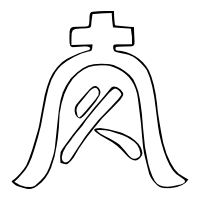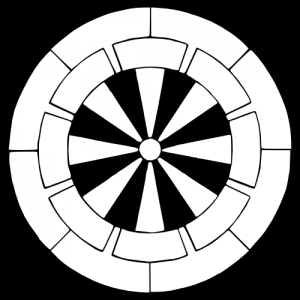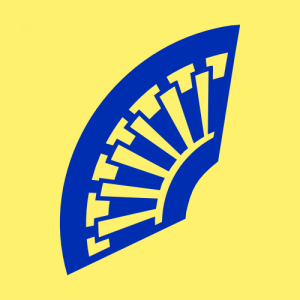Recreational research into Feudal Japan
Archive for August, 2010
Mon of the Week: Bell
Aug 24th (a Sembu (先負))
Today we look at another mon from the same collection of provincial samurai mon from the 15th century.(KJ:7) Today’s mon uses an enclosure that didn’t become a common element in Japanese mon despite its simplicity and elegance.
The enclosing shape appears to be a bell. Bells were associated with Buddhist temples, which used large bells to announce times for prayers, meals, and other such scheduled events in much the same way as Western churches and monasteries. These bells are struck from the outside by thick hanging wooden poles, instead of having an internal ringer and moving the bell itself with ropes.Watch movie online John Wick: Chapter 2 (2017)
The character inside is slightly mysterious despite being clearly drawn. It’s most probably a variation on 久, meaning ‘long time’, which in addition to being used in the Japanese equivalent of “long time no see” (久しぶり/hisashiburi) also has auspicious connotations of longevity.
While cross-like elements like the one present here would later be common in the mon of “secret Christians” (Kakure Kirishitan) after Christianity was outlawed in Japan, this particular mon predates such things. Here it perhaps represents a ring hanging the bell from a beam.
Similar bells would also be used as fire bells in the Edo period,(ja.wp:半鐘) when the population density and wooden construction in Edo caused frequent fires. In the peace of the Edo period, some warriors turned to serving in fire brigades summoned by such bells. More realistic, three-dimensional depictions of these bells are used in mon today.(Dower:105)
As a side note, a supposed veiled insult engraved on a temple bell is supposed to have triggered the Ōsaka Campaign,(en.wp:Bell_(instrument)) which is one good source of depictions of military mon.
On Making Kimono
Aug 15th (a Shakkō (赤口))
One of the classes I enjoyed this week at Pennsic University was Lady Roxanne’s Guide to Sewing Kosode and “Kimono” (handout soon to be available online at Yama Kaminari). I learned how to make kimono many years ago from my friend Chisato, and have made some modifications along the way, so I thought I’d post some responses. I highly recommend the class and handout; her similar class on hakama, which I caught last year, is also very useful.
Comments, in no particular order:
Neck Drop
I tend to do a less deep neck drop for my under layer kosode, to encourage it to be visible under an over layer. I know lots of people skip the under layer or use a fake collar for the effect, but I don’t tend to find two layers too hot. Then again, I often skip the pants, which is more appropriate for a monk than for a samurai.
Backseams
Lady Roxanne’s instructions leave you without a back seam. Back seams would have been necessary in period, due to narrow looms. They are also ‘traditionally’ associated with protection with evil spirits, but it’s unclear whether this is a product of more recent times, when they are no longer demanded by the fabric, or whether this tradition goes back further. The charms used for protection on backseamless kimono (such as those made for children) are cute, but I don’t know of any premodern examples.
Interestingly, Lady Roxanne does stick to traditional fabric widths for her sleeves, making them from a full panel and a half panel instead of a 1.5-panel width piece. I’ve been known to be lazy and skip seams in both places, but as far as I know there’s no mythology in sleeve seams.
Neck Hole
Lady Roxanne has you cut a semiellipse-shaped neck hole. Chisato’s method used a rectangular neck hole that has always made sewing on the collar a pain. I’d started rounding the corners of the neck hole to improve on this, but I bet using the semiellipse would make this work better.
Stitching
As Lady Roxanne mentioned in class, kimono would traditionally be unstitched to wash and the resewn. Kimono also had loose stitching because, if the kimono were to catch on something, it would be better for the stitching to come out (easily repairable) than for the fabric to rip. As someone whose kimonos have ripped many a time, this effect is hard to replicate on a sewing machine, but it’s something to keep in mind, at least when hand-sewing.
Collars
I like Lady Roxanne’s method of hand-sewing-on the collars and sewing them on the very edge of the fabric, to keep the quarter inch or so between a machine-sewed line and the edge from flipping up, like mine tend to do.
I also have the exact problem with short collars that Lady Roxanne mentions, and using long collars that go most of the way to the ground (instead of my current collar-to-the-end-of-the-diagonal) seems likely to fix it well. This is especially a problem when I wear my underkosode without an over layer (with hakama informally, or as part of a LARP costume), because of the reduced neck drop I do with underkosode.
Armpits
Lady Roxanne mentioned that most people seem to prefer closed armpits. I actually really like open armpits hot places (like Pennsic) so I can avoid my armpits getting all hot and sweaty; I was recently annoyed that I didn’t make the armpit holes big enough on my new underkosode. Open armpits also allow more freedom of motion.
Material
I recommend linen as being an easier-to-obtain fabric that is similar to the authentic hemp. Cotton is both rare in period and breathes less well. Of course, silk is also great and authentic.
Quilting
Lady Roxanne mentioned that the quilted kimono she has seen have quilting visible from the inside only. That’s good to know, since I’ve been thinking of making an actual Japanese warmth layer one of these days instead of just borrowing cloaks from people all over the place.
Overlap Pieces
I have a way of doing the front overlap pieces that saves fabric, if you know the angle you want to cut the front ahead of time, but is more complicated to explain. Instead of doing two full-height half-panel overlap pieces, leave yourself a single half-panel length. (Twice the kimono height minus neck drop is more than enough, but if you’re like me and want to use every part of the buffalo you can do this without cutting this piece to length.) Pin this piece to one side of the front, even at the bottom, and then draw and cut the angle for that half. Flip the remainder and it’ll be the right angle to attach on the other side. Note that this will do the wrong thing if your fabric has a vertically directional pattern, because one side’s overlap piece will be upside down relative to the other.
Sleeves
If you’re using pocket sleeves, be aware that things can fall out the back of the sleeves. With open armpits, sew up the back of the sleeve like you do on the front to make the pocket. I’m not sure how best to do this with closed armpits; you could sew a short seam between the sleeve and the body, but I’d worry that this would restrict arm motion.
I believe monkish overkimono would often have two-full-panel-width sleeves, so you could put your hands together completely covered by sleeve when praying in the cold. I think they also stayed larger-diameter as samurai sleeves became smaller and more practical.
I’d highly Lady Roxanne’s classes to anyone interested in making their own Japanese garb. She’s a great teacher and has ample experience. The handout’s great, but it doesn’t do her justice.
If you’re interested in more kimono references, you may wish to check out my Japanese garb page at The Academy of Seven Monkey, updated to include some links Lady Roxanne mentioned in class.
Auspicious Days, a dissenting view
Aug 4th (a Daian (大安))
A while back I talked about auspicious days and directions. I recently came upon a counterpoint reflecting the practical aspects of military thought. This is one of the seventeen testaments of Asakura Toshikage, one of the first Sengoku daimyō, the great lords of the Warring States period.(SoJT:429)
It is extremely regrettable if a commander, when fighting a battle that can be won or laying siege to a castle that can be taken, should change his time schedule after choosing an auspicious day and considering which directions are good and which are bad. But if a commander, disregarding auspicious days and favorable directions, assesses in detail the realities of the military situation, lays detailed plans for attacking, responds flexibly to circumstances as they present themselves, and maintains his basic strategy, he is sure to be victorious.
As I’m off to Pennsic War this week, I’ll be sure to follow this advice and completely ignore auspicious days while there. Now, back to packing.



